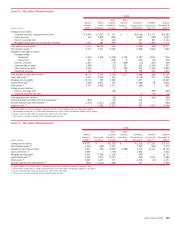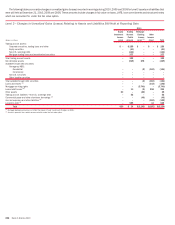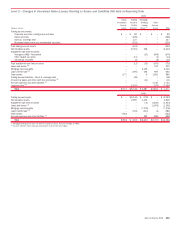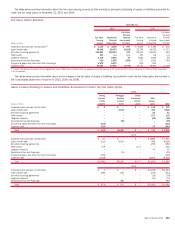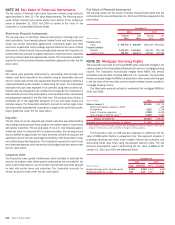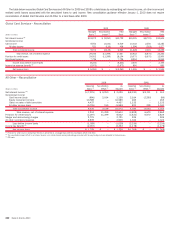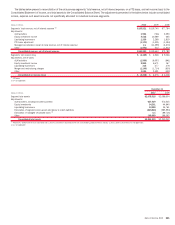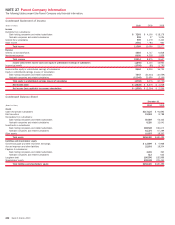Bank of America 2010 Annual Report Download - page 236
Download and view the complete annual report
Please find page 236 of the 2010 Bank of America annual report below. You can navigate through the pages in the report by either clicking on the pages listed below, or by using the keyword search tool below to find specific information within the annual report.
Nonrecurring Fair Value
Certain assets and liabilities are measured at fair value on a nonrecurring
basis and are not included in the previous tables in this Note. These assets
and liabilities primarily include LHFS, unfunded loan commitments
held-for-sale, goodwill and foreclosed properties. During 2010, the Corpora-
tion recorded goodwill impairment charges associated with the Global Card
Services and Home Loans & Insurance business segments of $10.4 billion
and $2.0 billion. The fair value of the goodwill balance for Global Card
Services and Home Loans & Insurance was $11.9 billion and $2.8 billion
at December 31, 2010. See Note 10 – Goodwill and Intangible Assets for
additional information on the goodwill impairment charges. The amounts
below represent only balances measured at fair value during the year and still
held as of the reporting date.
Assets and Liabilities Measured at Fair Value on a Nonrecur-
ring Basis
(Dollars in millions)
Level 2 Level 3 in 2010
December 31, 2010 Gains (Losses)
Assets
Loans held-for-sale
$931 $ 6,408 $ 174
Loans and leases
(1)
23 11,917 (6,074)
Foreclosed properties
(2)
10 2,125 (240)
Other assets
8 95 (50)
(Dollars in millions)
Level 2 Level 3 in 2009
December 31, 2009 Gains (Losses)
Assets
Loans held-for-sale $2,320 $7,248 $(1,288)
Loans and leases
(1)
– 8,602 (5,596)
Foreclosed properties
(2)
– 644 (322)
Other assets 31 322 (268)
(1)
Gains (losses) represent charge-offs associated with real estate-secured loans that exceed 180 days past due.
(2)
Amounts are included in other assets on the Consolidated Balance Sheet and represent fair value and related
losses on foreclosed properties that were written down subsequent to their initial classification as foreclosed
properties.
NOTE 23 Fair Value Option
Corporate Loans and Loan Commitments
The Corporation elected to account for certain large corporate loans and loan
commitments which exceeded the Corporation’s single name credit risk
concentration guidelines under the fair value option. Lending commitments,
both funded and unfunded, are actively managed and monitored and, as
appropriate, credit risk for these lending relationships may be mitigated
through the use of credit derivatives, with the Corporation’s public side credit
view and market perspectives determining the size and timing of the hedging
activity. These credit derivatives do not meet the requirements for derivatives
designated as accounting hedges and therefore are carried at fair value with
changes in fair value recorded in other income (loss). Electing the fair value
option allows the Corporation to carry these loans and loan commitments at
fair value, which is more consistent with management’s view of the underlying
economics and the manner in which they are managed. In addition, account-
ing for these loans and loan commitments at fair value reduces the account-
ing asymmetry that would otherwise result from carrying the loans at histor-
ical cost and the credit derivatives at fair value.
Loans Held-for-Sale
The Corporation elected to account for certain LHFS at fair value. Electing the
fair value option allows a better offset of the changes in fair values of the
loans and the derivative instruments used to economically hedge them. The
Corporation has not elected to account for other LHFS under the fair value
option primarily because these loans are floating-rate loans that are not
economically hedged using derivative instruments. Residential mortgage
LHFS, commercial mortgage LHFS and other LHFS are accounted for under
the fair value option with interest income on these LHFS recorded in other
interest income. The changes in fair value are largely offset by hedging
activities. An immaterial portion of these amounts was attributable to
changes in instrument-specific credit risk.
Other Assets
The Corporation elected to account for certain other assets under the fair
value option including private equity investments.
Securities Financing Agreements
The Corporation elected to account for certain securities financing agree-
ments, including resale and repurchase agreements, under the fair value
option based on the tenor of the agreements, which reflects the magnitude of
the interest rate risk. The majority of securities financing agreements collat-
eralized by U.S. government securities were excluded from the fair value
option election as these contracts are generally short-dated and therefore the
interest rate risk is not significant.
Long-term Deposits
The Corporation elected to account for certain long-term fixed-rate and rate-
linked deposits, which are economically hedged with derivatives, under the
fair value option. Election of the fair value option allows the Corporation to
reduce the accounting volatility that would otherwise result from the account-
ing asymmetry created by accounting for the financial instruments at histor-
ical cost and the economic hedges at fair value. The Corporation did not elect
to carry other long-term deposits at fair value because they were not eco-
nomically hedged using derivatives.
Commercial Paper and Other Short-term Borrowings
The Corporation elected to account for certain commercial paper and other
short-term borrowings under the fair value option. This debt is risk-managed
onafairvaluebasis.
Long-term Debt
The Corporation elected to account for certain long-term debt, primarily
structured notes that were acquired as part of the Merrill Lynch acquisition,
under the fair value option. This long-term debt is risk-managed on a fair value
basis. Election of the fair value option allows the Corporation to reduce the
accounting volatility that would otherwise result from the accounting asym-
metry created by accounting for these financial instruments at historical cost
and the related economic hedges at fair value.
Asset-backed Secured Financings
The Corporation elected to account for certain asset-backed secured financ-
ings that were acquired as part of the Countrywide acquisition, which are
classified in commercial paper and other short-term borrowings, under the fair
value option. Election of the fair value option allows the Corporation to reduce
the accounting volatility that would otherwise result from the accounting
asymmetry created by accounting for the asset-backed secured financings
at historical cost and the corresponding mortgage LHFS securing these
financings at fair value.
234 Bank of America 2010







